The Best Headless Shopify Examples For Inspiration (Updating)
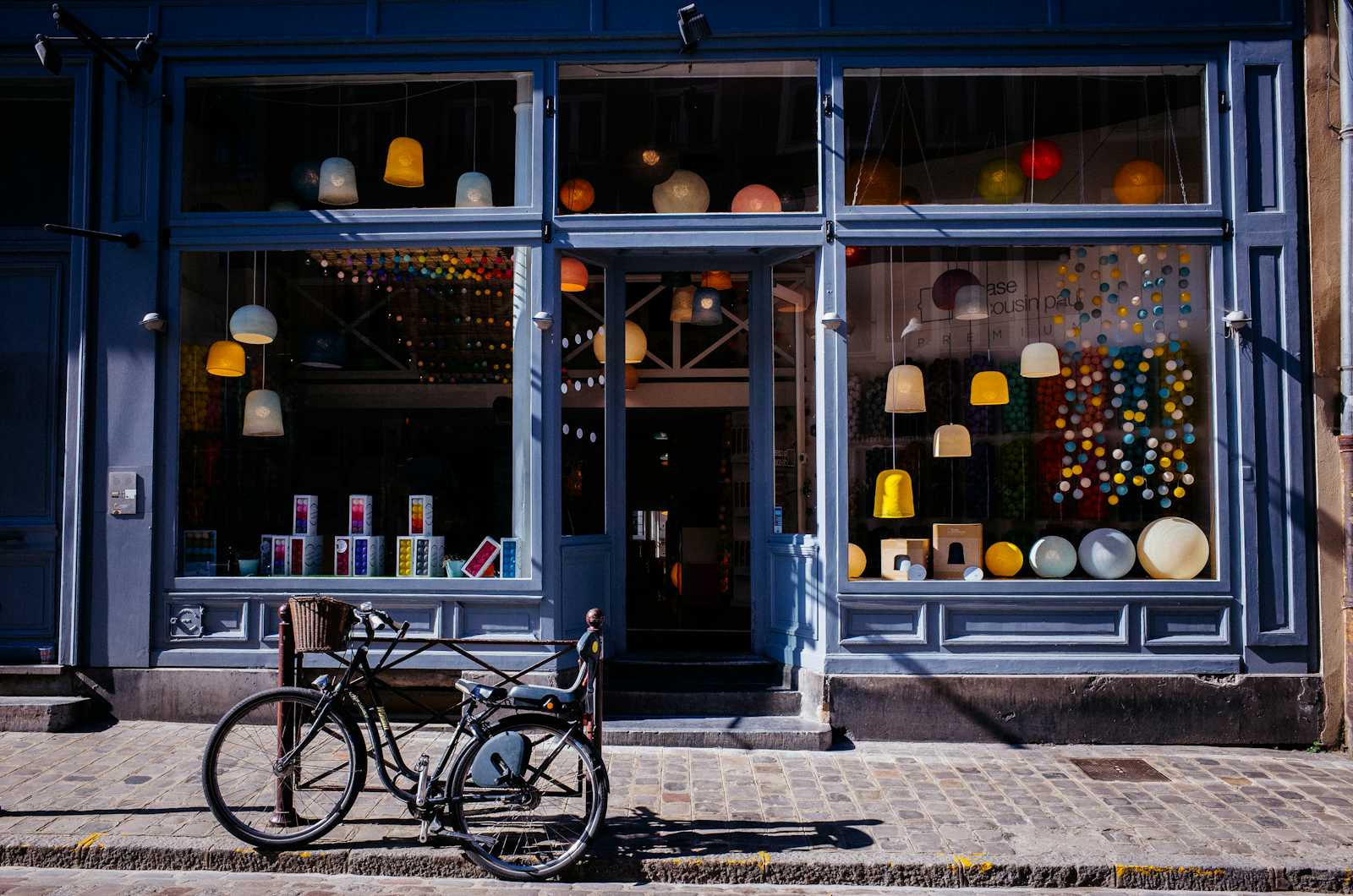
I. Shopify, Without Headless
We all know and love Shopify.
Over the relentless march of time (the one concept even the best DTC brands cannot make a quick sale of), Shopify has proved itself not just capable of survival - the competition between eCommerce platforms has always been tough - but a master of evolution, a sort of eCommerce Darwin’s dream, deftly adapting to the ever-shifting desires and needs of their eCommerce merchants.
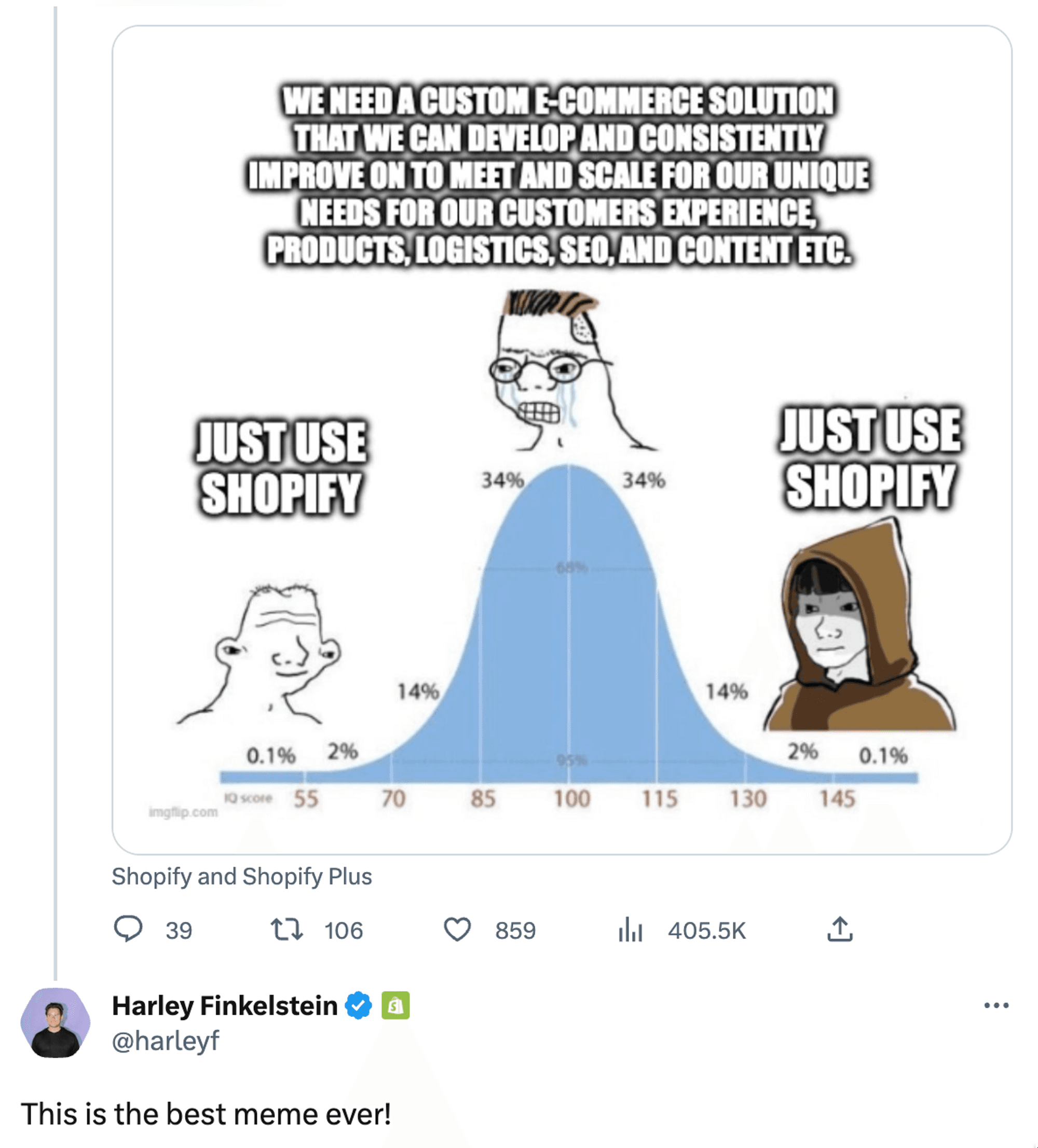
However, Shopify has its limitations, which is in the name of Liquid.
Shopify Liquid, despite being the current backbone of all Shopify websites, has some major drawbacks and limitations.
1.1. Vendor lock-in risk
Liquid theme binds your code to Shopify - so if you want to migrate to a different system, good luck.
The liquid is (seemingly) built under the assumption that companies won’t evolve because it makes the e-commerce platform the hub around which the whole apparatus of success spins. When brands have to change their platform, the entire system might go to waste - translating into the loss of resources: thousands of hours and hundreds of thousands of dollars down the drain.
1.2. Customization with Liquid in the background takes a toll on developers
The available options with Liquid are severely limited, whereas installing apps may incur additional fees and hamper performance. You can use additional app scripts, but they can conflict with your theme code, which results in even more redundant and non-reusable code. Any developer with a DRY mindset (don’t repeat yourself) would hate it.
1.3. The need for better performance optimization.
The liquid is a backend template language used for static content generation, therefore if you want to make a website more interactive and responsive, you have to use an additional 3rd script, and this guarantees to put a brake on your site’s loading speed.
The most fundamental drawback is that Liquid is a template language. A template language is always a tough nut to crack. Custom databases and complex logic become more formidable to implement. I remember reading this somewhere on Shopify Reddit - which perfectly captures the biggest drawback of Liquid:
“Liquid theme restricts you to how and what you can develop. Do you want to create a single-page application? No. Perhaps a progressive web application? No. Is it possible to unit-test your markup? Again, no! Even custom URLs are not an option.”
The engineering wizards at Shopify were acutely aware of these drawbacks - they must have been because they did come up with a plan, a brilliant one at that: Shopify Hydrogen
II. Shopify, After Headless, With Hydrogen
Shopify Hydrogen is a new programming language specifically designed to improve the performance and scalability of Shopify stores. With Hydrogen, developers, and merchants can build headless storefronts the way they dream of.
Hydrogen is intended to be a replacement for Liquid - and Shopify is pushing for it with vigor. They acquired the community-favorite RemixJS and planned to use it to enhance Hydrogen’s stability and performance. They brought it to market with ferocity and convinced even the biggest Consumer brands - like Allbirds, Tommy Hilfiger, or ButcherBox - to adopt it.
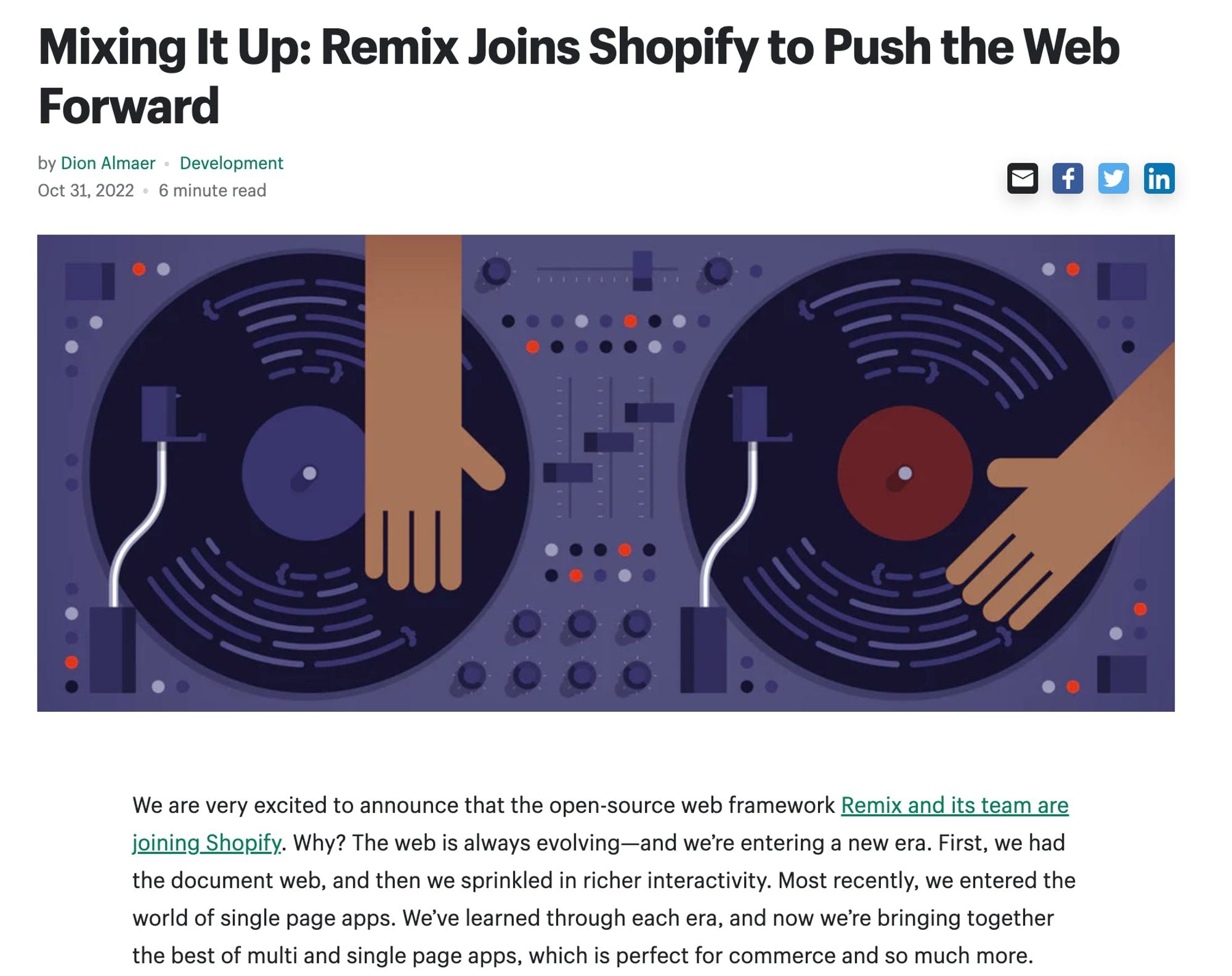
With the Remix team at Shopify, developers building on Shopify will benefit from new tools that they will love, and merchants will see custom storefronts that are faster than ever with an improved Hydrogen product. The Remix open-source community will have a strong sponsor and supporter they can trust to enable the framework to accelerate its roadmap, with the knowledge that they can bet on the framework for the long run. While Hydrogen is focused on commerce, Remix is focused lower in the stack, and will continue to be a general web solution that scales from content through commerce and all the way to apps. Shopify will use Remix across many projects where it makes sense, and you can expect to see more of our developer platform with first-class Remix support over time.
The possibilities with Hydrogen are abundant:
-
Developers can create fully custom websites with access to the controllers and models, making complex logic and third-party service requests possible. Hydrogen also does not tightly couple code to the Shopify platform, meaning businesses can change platforms without having to start from scratch.
-
Better Flexibility: Hydrogen enables developers to create a single-page application, a progressive web application, and to unit-test their code. It also supports custom URLs and has better performance than Liquid.
-
Enhanced performance: Hydrogen is optimized for performance and is able to handle large volumes of traffic more efficiently than Liquid. This means that stores built with Hydrogen may load faster and be more responsive.
-
Better error handling: Hydrogen has improved error handling and debugging capabilities, making it easier to identify and fix problems with your store.
-
Improved developer experience: Hydrogen is designed to be easier to learn and use than Liquid, which should make it easier for developers to build and maintain Shopify stores.
As Shopify developers, I wager we’re at the threshold of a complete disruption - the eCommerce equivalent of transitioning from horse-drawn vehicles to automobiles. And using Hydrogen, merchants and brands have already incredible shopping experiences - those that are story-infused, blazing-fast, and unbelievably frictionless.
Still, you might wonder, what Shopify Headless is even good for.
If you're still on the fence, this checklist might be helpful.
III. Common Headless Use Cases
Headless commerce presents various use cases that address the limitations of traditional e-commerce platforms:
-
Rapid Experimentations, Without Losing Performance: A/B testing and dynamic content are a vital part of the eCommerce experience. They can make, or break sales. The server-side capabilities and caching of Hydrogen can allow merchants to have a lot of A/B testing and dynamic, personalized content without sacrificing performance and speed.
-
Immersive Product Visualization: Traditional site designs often limit how your products are presented to shoppers. With headless, you can incorporate features like 360-degree views, AR, and other interactive elements - without fear of losing speed - and offer a more immersive customer experience.
-
Improved Site Performance: Over time, every Shopify storefront can suffer from performance issues due to accumulated custom code and plugins. A headless approach maintains a clean codebase, leading to better maintainability and faster development cycles.
-
Composable Commerce: Headless architecture supports composable commerce, meaning you can integrate various services like CDN for images, Cloudflare for scripts, and Algolia for search functionalities, enhancing site speed and user experience.
-
Localization and Personalization: Headless platforms can dynamically serve localized content and personalized experiences by leveraging frontend frameworks and global server networks.
-
Unified Customer Experience: Full control over the front end allows businesses to tailor the shopping experience to their brand and customer needs without backend constraints.
-
AI Integration: Easily integrate AI and machine learning models to provide personalized shopping experiences, chatbots, recommendation engines, and more, all facilitated by the API-driven nature of headless commerce.
25 Best Headless Shopify Examples
1. Victoria Beckham Beauty: Immersive Fashion with Headless Architecture
Victoria Beckham Beauty presents itself as a paradigm of luxury and clean beauty. By going headless, it has effectively merged e-commerce capabilities with an elegant, narrative-driven design to align with its brand ethos and luxury offerings.
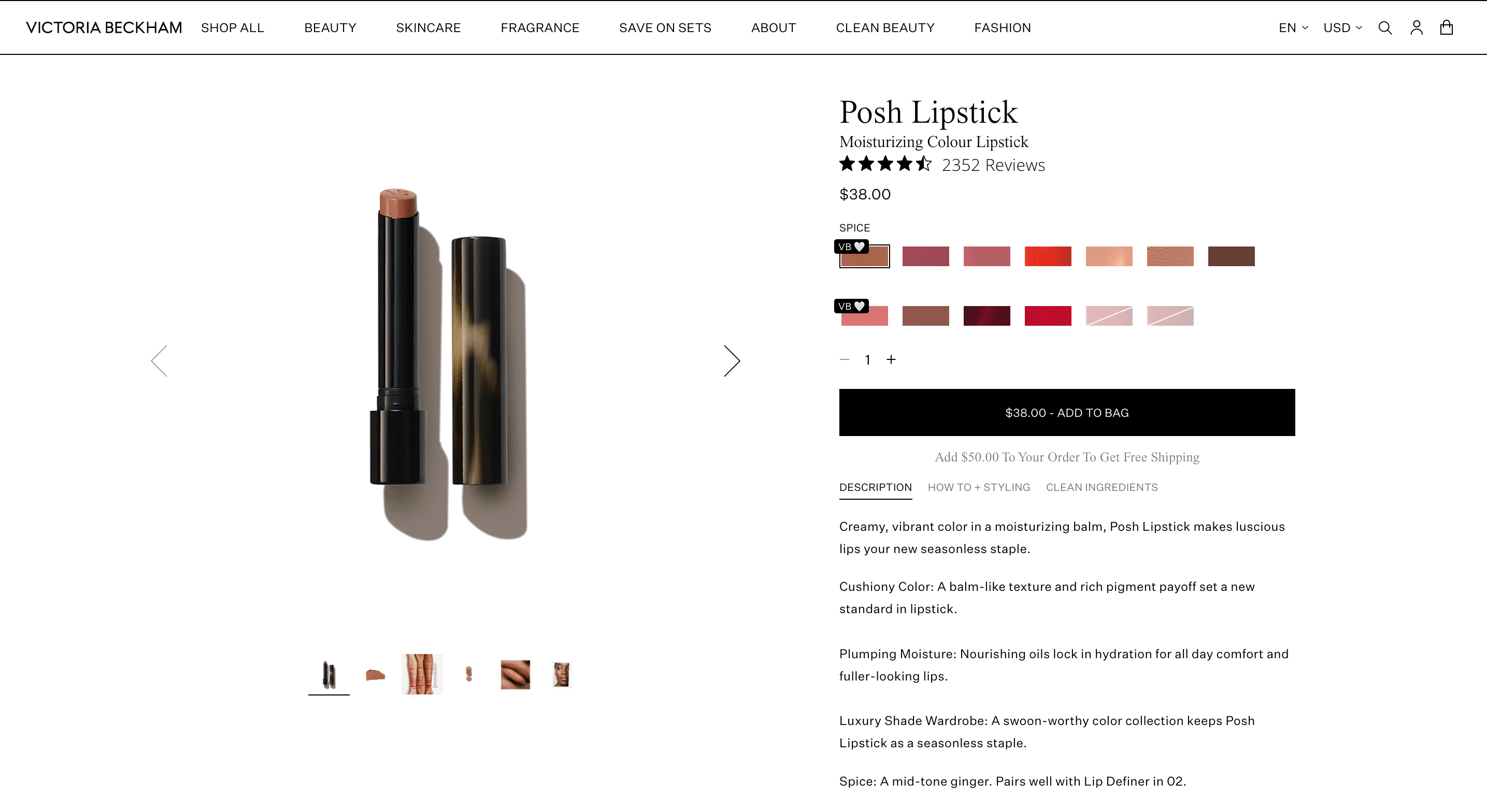
With Shopify Headless, Victoria Beckham Beauty can achieve:
-
Enhanced Speed and Performance: By adopting a headless architecture through Contentful and Netlify, alongside Shopify Plus, Victoria Beckham Beauty has significantly improved its site's performance. This transformation has led to a faster digital experience, critical for maintaining customer engagement and reducing bounce rates.
-
More Flexibility: VBB leveraged the headless approach for greater control and speed, enabling rapid changes and updates to the site without backend dependencies. This adaptability helps them launch promotional campaigns and product launches a lot quicker.
-
Seamless Integrations: Utilizing the Jamstack architecture, Victoria Beckham Beauty has streamlined its build and deployment processes. Integration of various services like Contentful and Shopify Plus into the Netlify platform has created a high-performing, interactive site that supports the brand's innovative and luxurious image.
2. Bols: Crafting Rich Customer Experiences
Bols, known for its rich heritage in liqueur and spirits, leverages the flexibility of Shopify's headless architecture to boost its online presence.
With Shopify Headless, Bols was able to achieve:
-
Increased Page Loading Speed: Implementing headless architecture has resulted in a 50% increase in page loading times, significantly enhancing user experience.
-
Customized Content-Rich Experience: The headless approach has granted Bols complete control over its storefront, enabling a content-rich browsing experience for customers.
-
Global Expansion: The flexibility provided by headless commerce has supported Bols in its mission to expand direct-to-consumer sales globally.
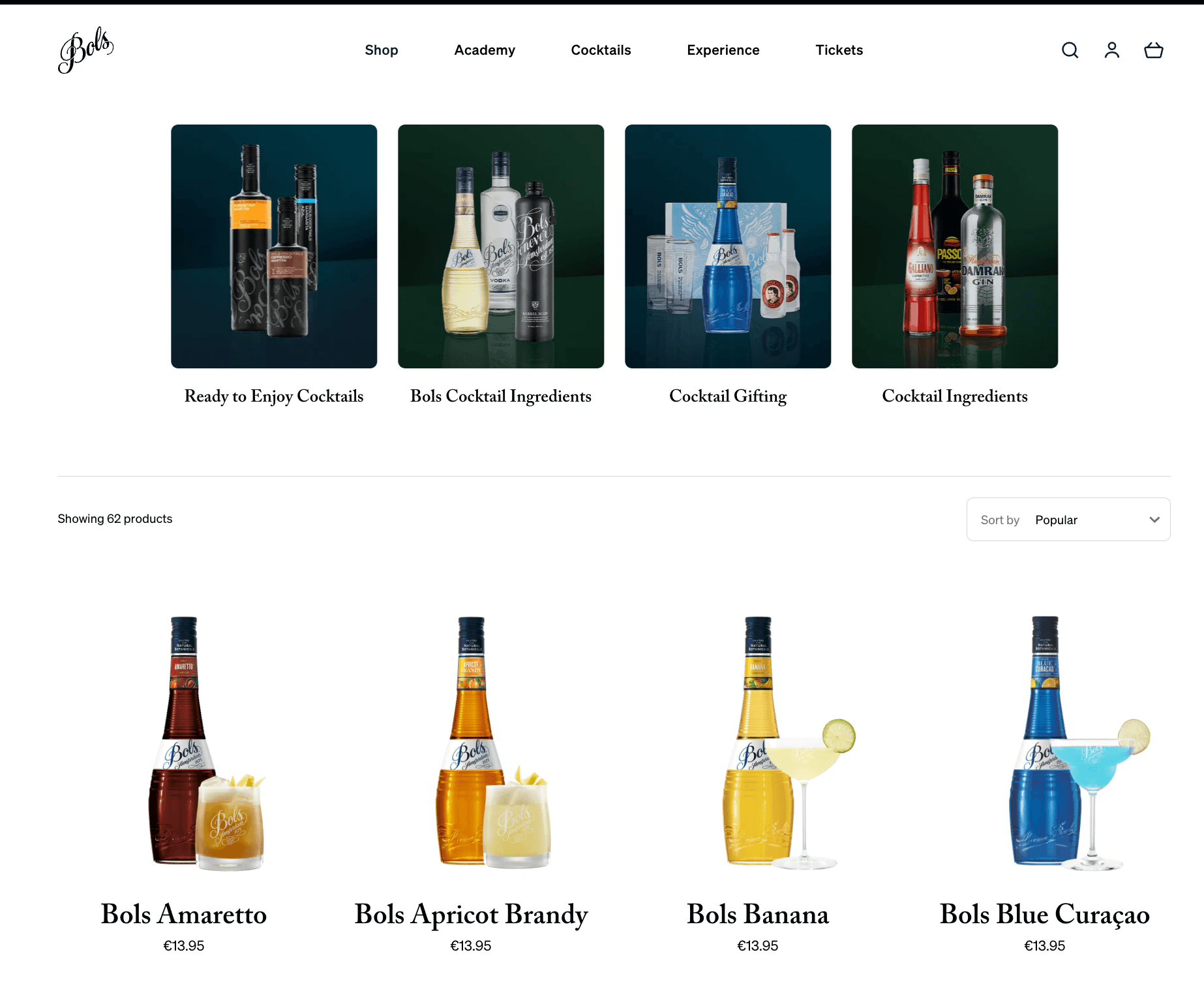
3. Denim Tears: Crafting Cultural Narratives
To maintain its narrative-driven approach and integrate diverse multimedia content seamlessly, Denim Tears went headless with Shopify. By taking full advantage of Hydrogen, Denim Tears can showcase cultural stories through fashion, requiring a platform that supports rich, immersive storytelling.
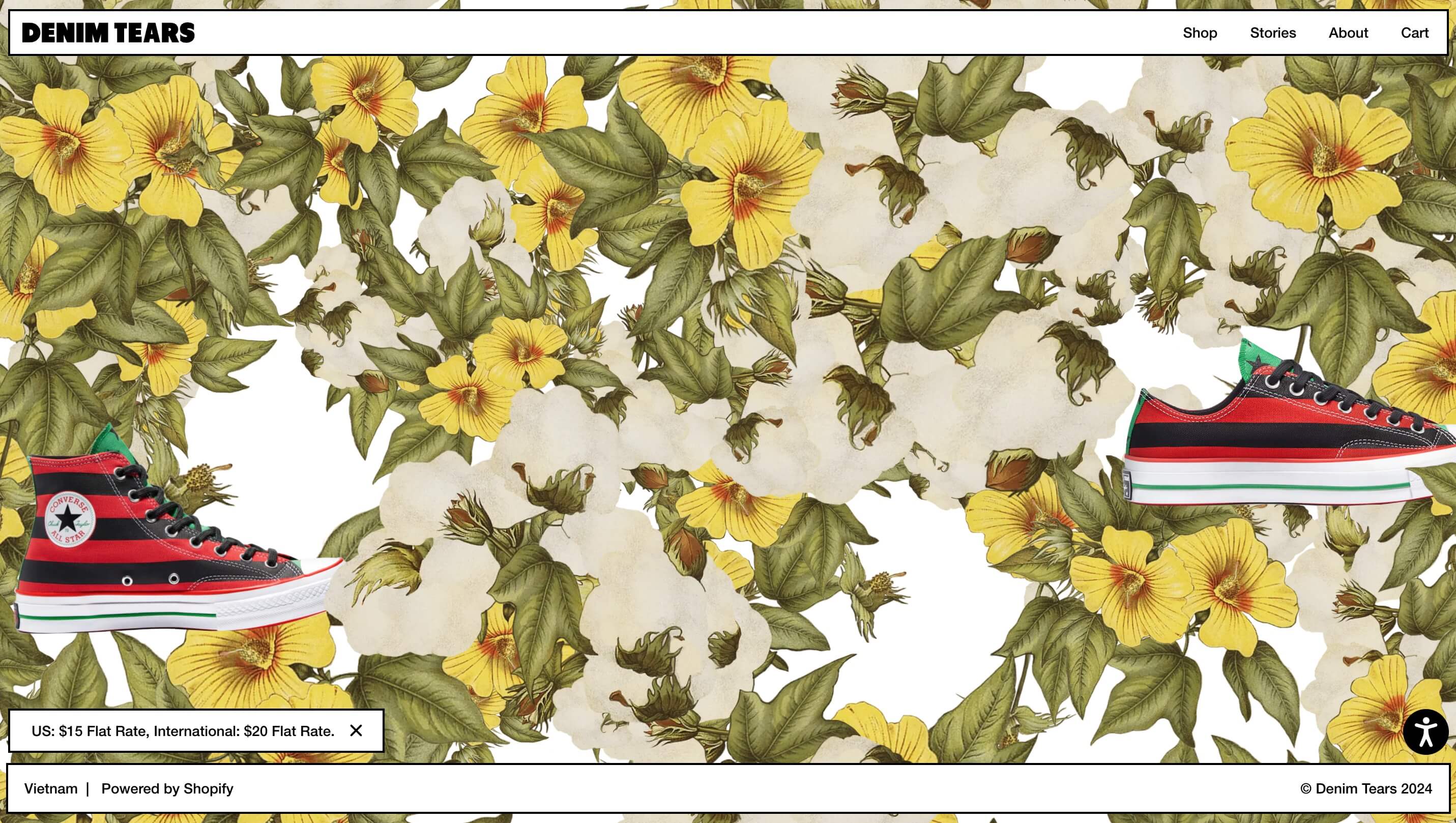
With Shopify Headless, Denim Tears was able to achieve:
-
Rich Storytelling: Enhanced content display capabilities, supporting their unique brand storytelling.
-
Enhanced User Experience: Fast, responsive, and interactive site elements that engage users deeply with the brand’s heritage.
4. Atoms: Personalized Shopping Made Easy
With Headless, Atoms was able to focus on comfort and customization, offering unique shoe designs that cater to individual preferences.
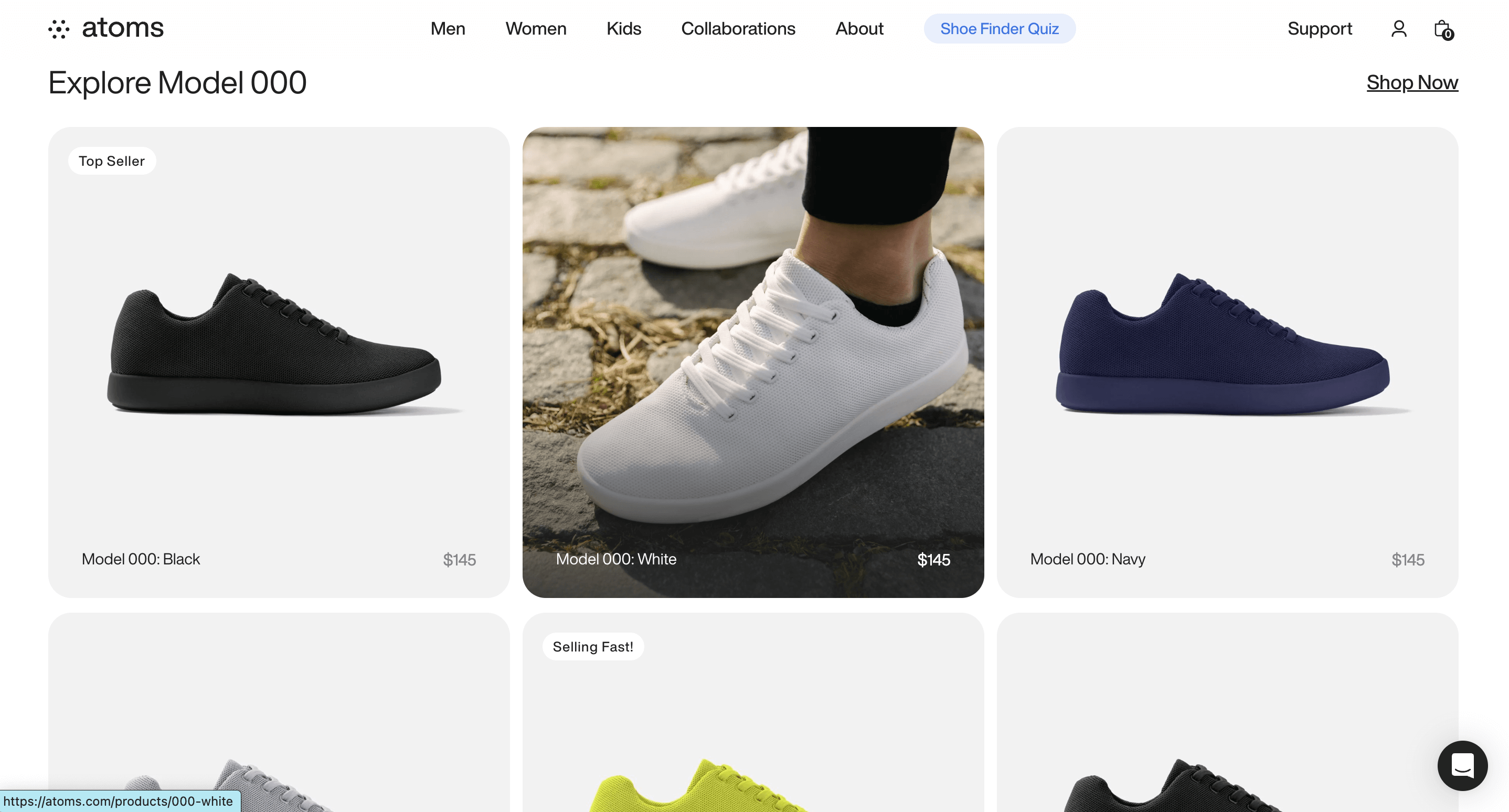
Going headless with Shopify, Atoms was able to achieve:
-
Customization at Scale: Efficient management of varied product options and user preferences.
-
Streamlined User Journeys: Smooth, intuitive shopping experiences tailored to individual needs and behaviors.
For the full case study, read it here.
4. Half Helix: Helping Merchants Innovate
Half Helix is a group of passionate designers, developers, and technologists committed to building modern, thoughtful digital experiences in an ever-changing world. By leveraging Shopify's headless capabilities, Half Helix can achieve better customization and more scalability in their tech stack.
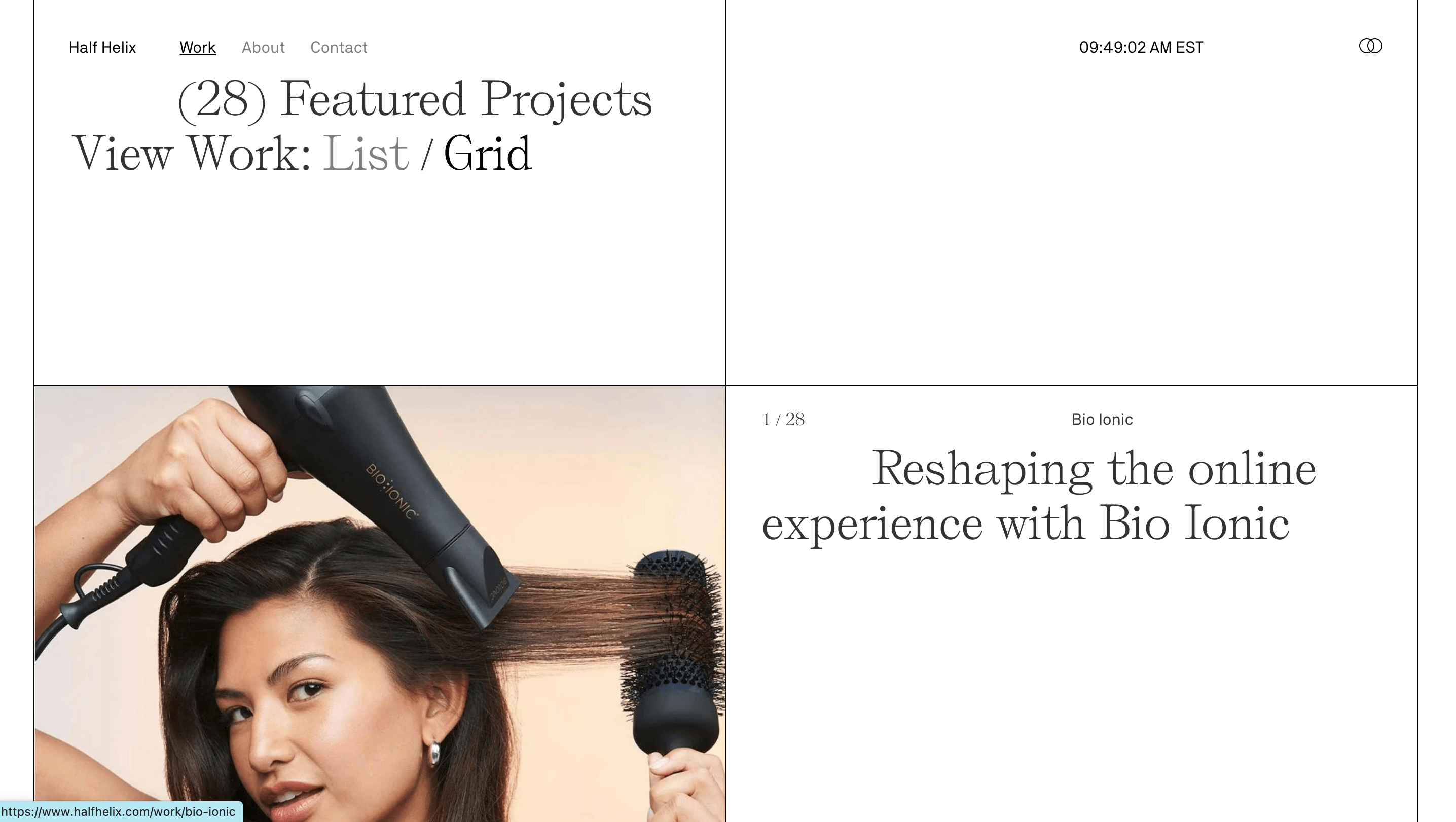
-
Innovative Solutions and Customizations: The agency has utilized headless commerce to provide unique, tailored e-commerce experiences, showcasing their capability to adapt and innovate in the digital space.
-
Scalability and Efficiency: The adoption of headless architectures typically results in scalable and efficient digital platforms, though specific results for Half Helix were not detailed.
5. Boretti: Streamlining Luxury Kitchen Experience
Boretti is renowned for its high-end kitchen appliances and culinary products, offering an elegant online platform to match its luxury goods.
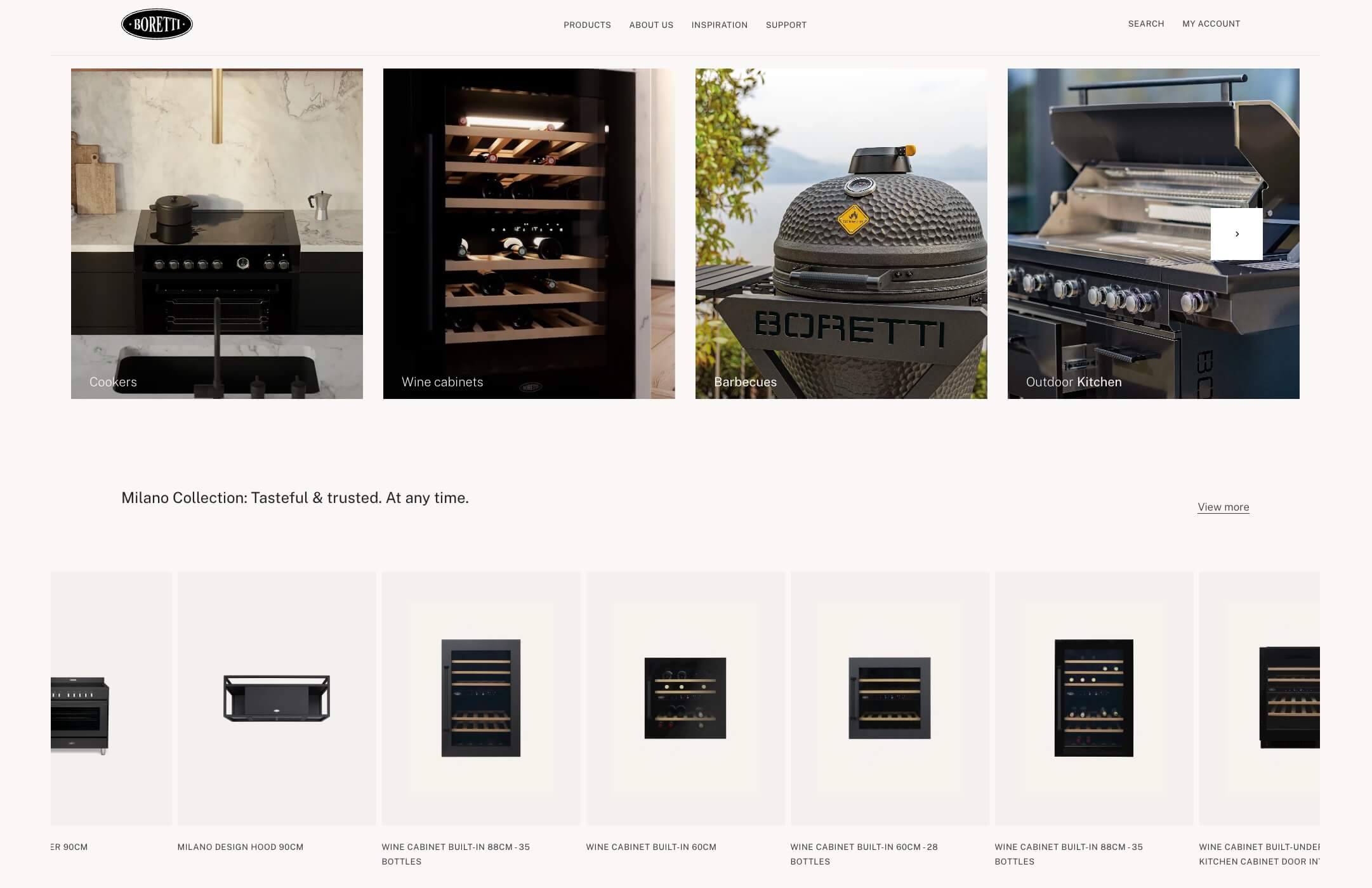
To match the sophisticated nature of its products and clientele, Boretti required a flexible, high-performing website that could offer a bespoke user experience, reflecting the brand's high quality and attention to detail.
Naturally, they went for headless Shopify to achieve:
-
Dynamic User Experiences: The headless approach would enable Boretti to offer personalized shopping experiences, with tailored recommendations and interactive product displays.
-
Scalability and Integration: Headless architecture would allow for easier updates and integrations, keeping the site current with the latest e-commerce trends and customer demands.
6. Nour Hammour: Tailoring Luxury eCommerce Fashion
Nour Hammour offers a curated selection of luxury leather jackets and fashion pieces, each crafted with care and precision. Known for its bespoke products, Nour Hammour needed a digital presence that could offer personalized experiences and showcase its fashion items in high detail.
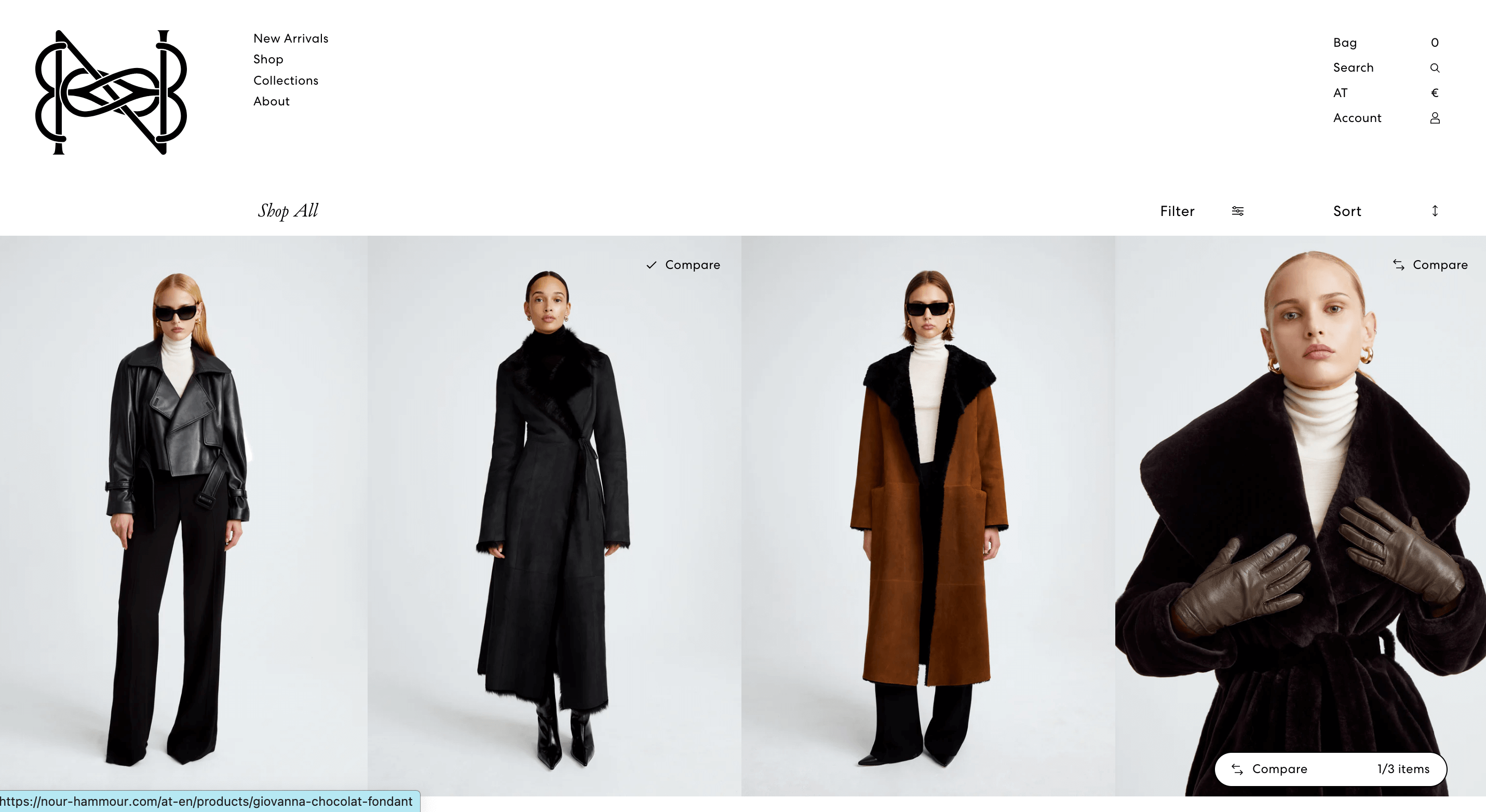
With Headless, Nour Hammour was able to achieve:
-
Improved Site Interactivity and Engagement: By adopting a headless approach, Nour Hammour could create more interactive and engaging product pages, enhancing the shopping experience.
-
Faster Market Adaptation: The flexibility of a headless system would allow Nour Hammour to quickly adapt online content and marketing strategies to the fast-paced fashion industry.
For the full case study, read it here.
7. Isle USA: Pioneering Adventure
Isle USA is dedicated to providing high-quality paddleboards and accessories, catering to outdoor enthusiasts and adventure seekers.
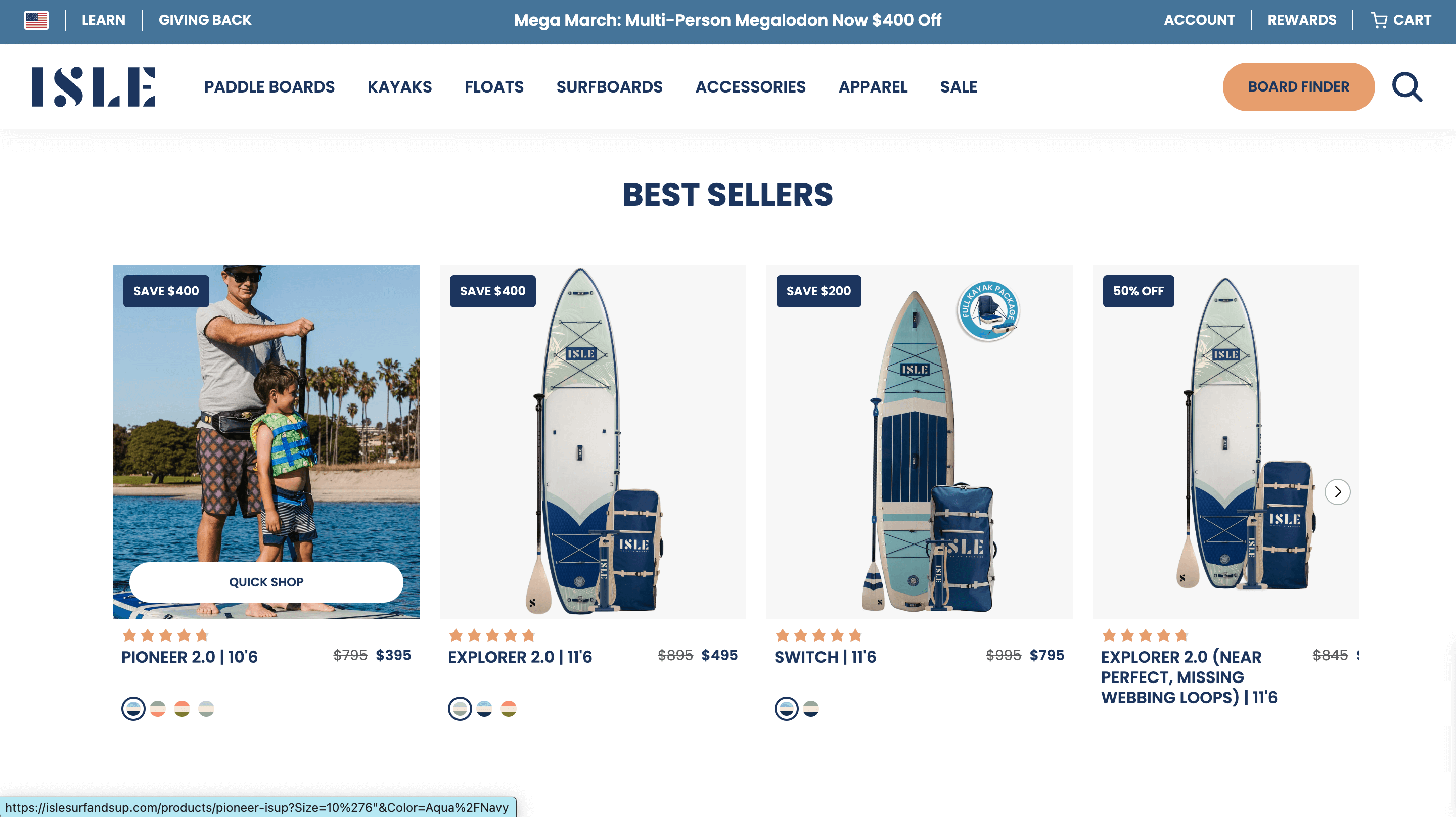
To cater to a diverse range of customers and outdoor activities, Isle required a dynamic website capable of offering detailed product information, guides, and an engaging shopping experience. And they achieved it with Shopify Headless:
-
Rich Content Delivery: Utilizing headless commerce, Isle USA could effectively manage and deliver rich content such as video tutorials, adventure guides, and detailed product specs.
-
Operational Efficiency: The headless architecture would streamline content updates and product management, allowing Isle to efficiently respond to seasonal trends and customer needs.
8. Splits59: Enhancing Fitness Fashion
Splits59 offers fashionable, high-performance activewear designed to support and inspire women in their fitness journeys. With a focus on high-energy, dynamic fitness attire, Splits59 required a website that could match the brand's vibrant style and need for high functionality.
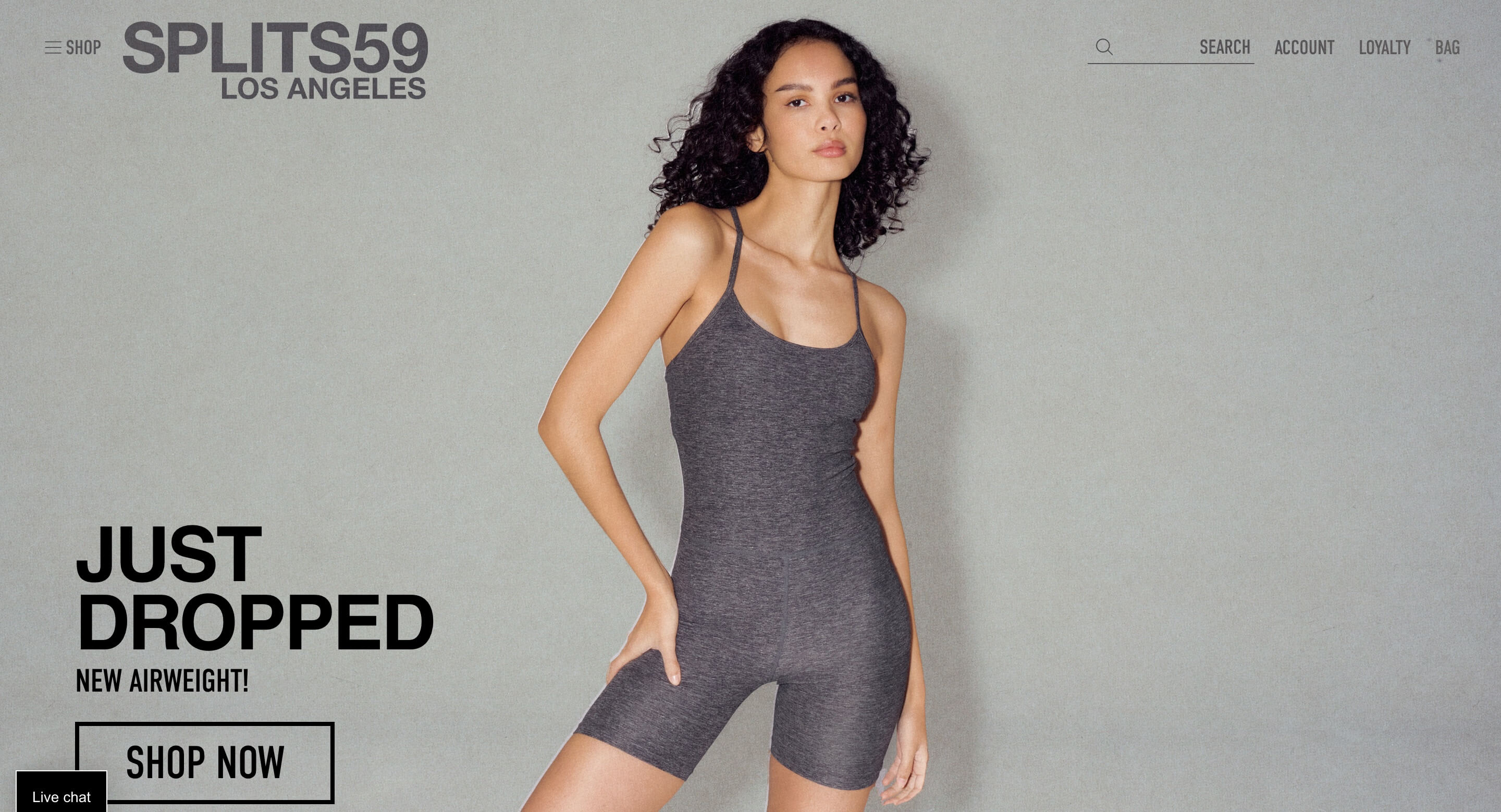
With Shopify, Splits59 was able to achieve:
-
Seamless Shopping Experience: By adopting headless commerce, Splits59 could provide a fluid, user-friendly shopping experience, catering to customers looking for fitness wear that meets their style and performance needs.
-
Dynamic Content and Interaction: The headless approach enables Splits59 to offer dynamic content such as fitness tips, product launches, and interactive sizing guides.
-
Market Agility: Headless commerce would allow for rapid updates and personalization, essential for keeping pace with the fast-moving fitness and fashion sectors.
9. Magda Butrym: Redefining Luxury Fashion
Magda Butrym offers luxury fashion pieces that combine modern design with traditional craftsmanship, appealing to a discerning global clientele.
To showcase its detailed, high-end products and provide an exclusive shopping experience, Magda Butrym required a sophisticated, flexible e-commerce platform. With Headless, they was able to do so:
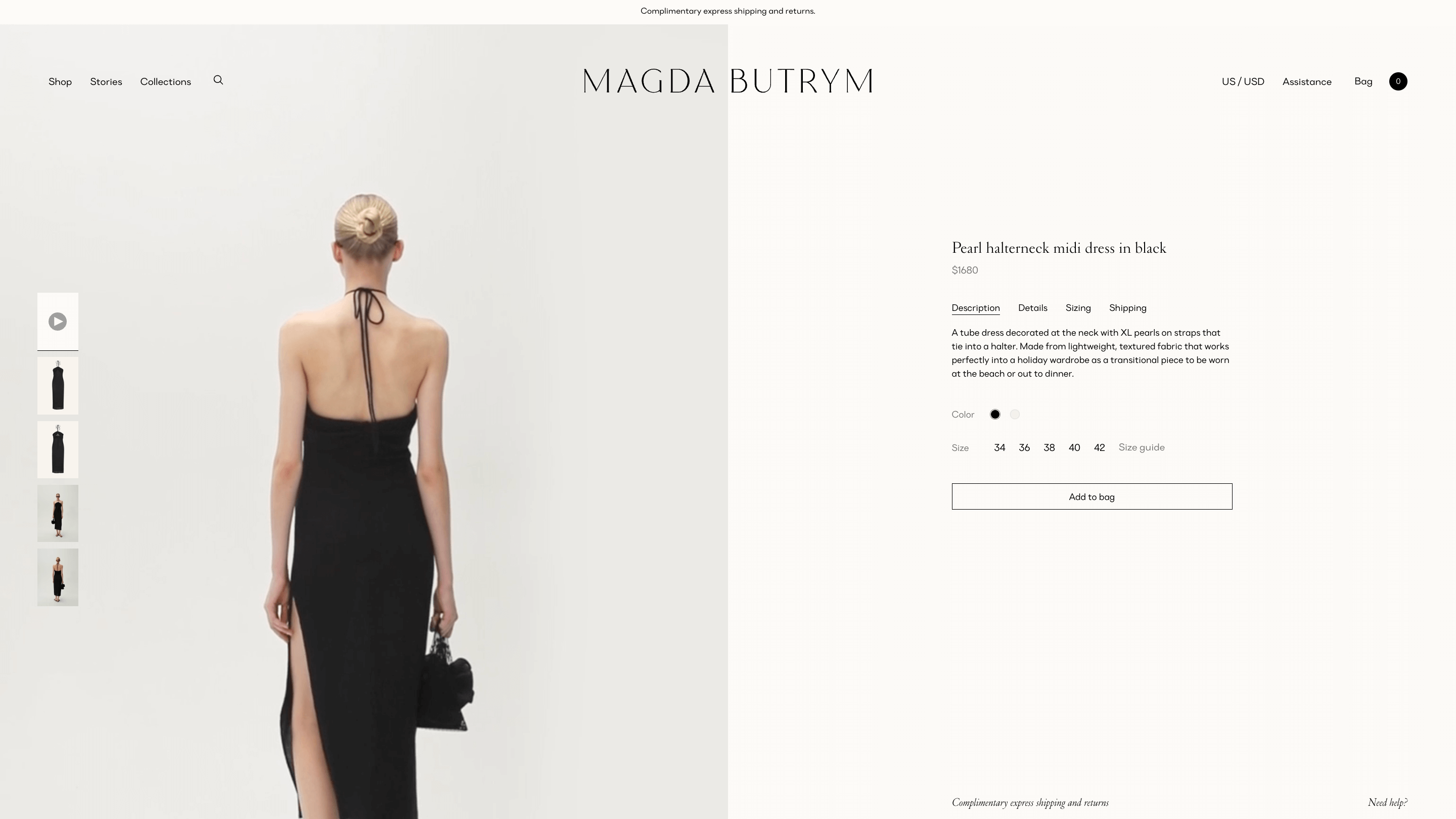
-
Elevated Brand Presentation: A headless approach would allow Magda Butrym to create a unique and immersive online environment that reflects the brand's luxury and quality.
-
Global Customer Reach: With headless commerce, Magda Butrym could easily manage international content and sales, catering to a global audience while maintaining localized experiences.
-
Innovative Shopping Features: The brand could implement advanced features such as virtual try-ons or personalized styling advice, enhancing the online shopping experience for luxury fashion consumers.
10. Chubbies: Championing Weekend Wear with Headless Shopify
Chubbies has carved out a unique niche in the men's fashion industry, specializing in vintage-inspired shorts. Their mission is to promote the weekend lifestyle, encouraging relaxation and fun.
Given their rapid growth and distinctive brand identity, Chubbies needed a robust e-commerce solution to manage increasing traffic and provide a seamless, engaging user experience. A headless architecture would allow them to scale effectively while maintaining their unique brand voice and marketing strategies.
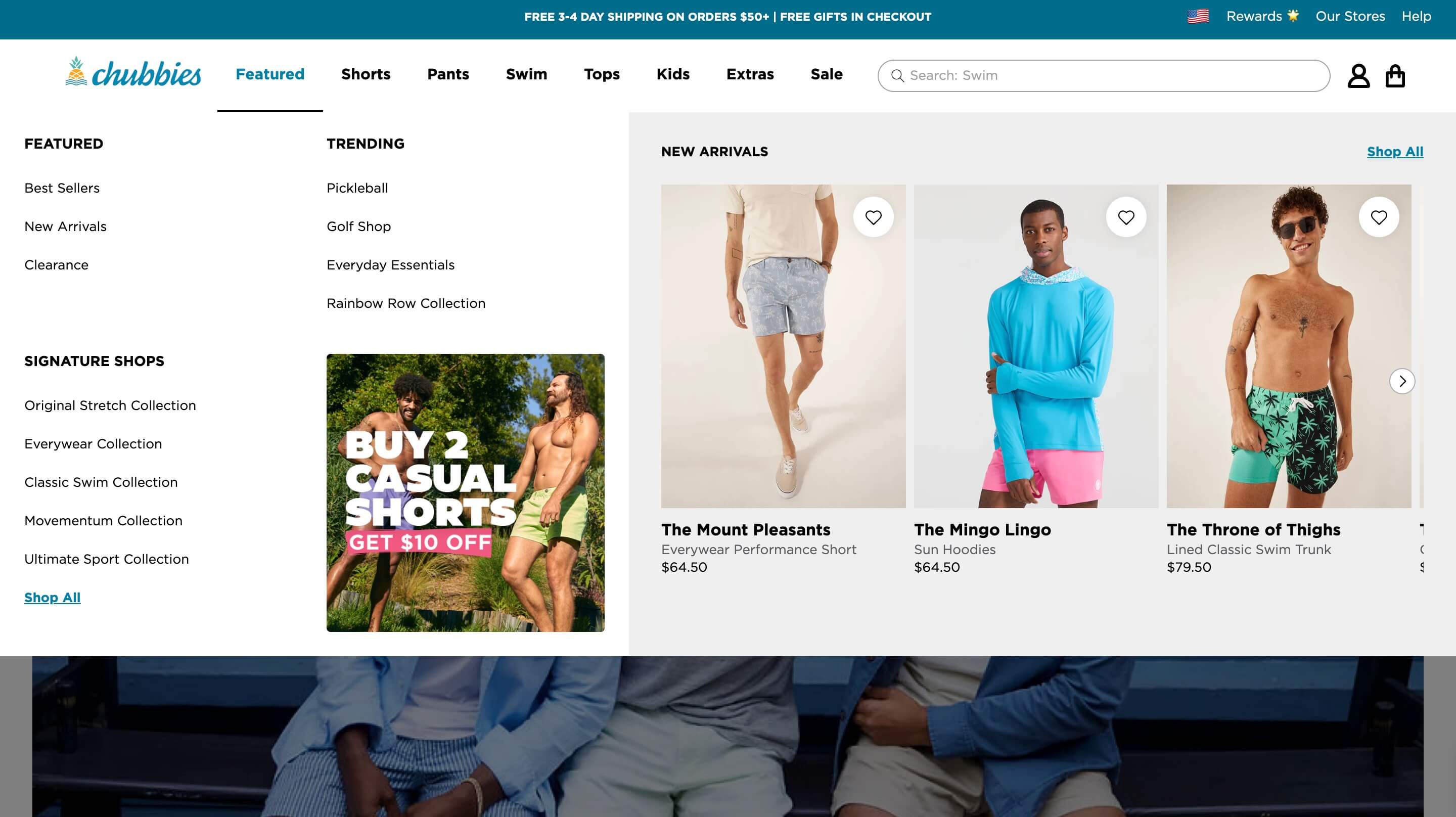
With Headless, Chubbies was able to support a brand's rapid growth:
-
Significant Sales Growth: Adopting Shopify Plus and a headless approach contributed to a 50% year-over-year sales growth, demonstrating the effectiveness of their digital strategy.
-
Expanded Community Reach: Their approach helped grow their email list to 1.5 million and social media following to over 2 million, illustrating the power of their brand and lifestyle messaging.
For more detailed insights, you might want to explore Shopify's case study on Chubbies.
11. Veloretti: Revolutionizing Urban Cycling
Veloretti, an Amsterdam-based brand, is known for its hand-crafted, affordable bicycles. They aimed to elevate their digital presence with the launch of their first electric bike and a complete rebranding of their flagship store.
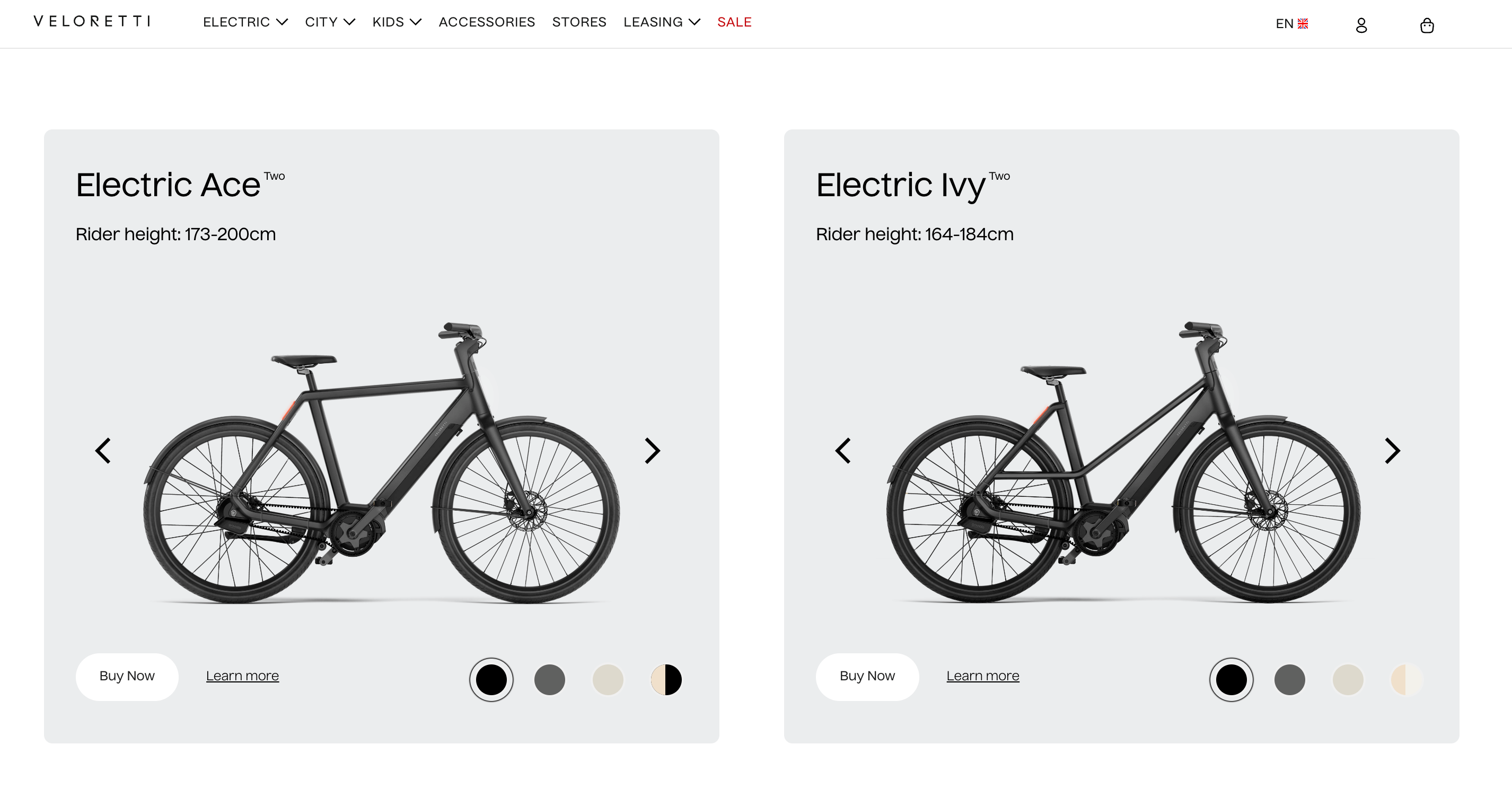
The transition to headless commerce allowed Veloretti to enhance overall performance and operational flexibility. This was crucial as they moved into the electric bike market and needed a platform that could handle complex product configurations and provide a seamless user experience.
12. Paul Valentine: Elevating Luxury E-commerce with Headless
Paul Valentine, a German-based premium jewelry and accessory brand, recognized the need to expand its reach internationally. This ambition required a scalable and flexible digital infrastructure to accommodate various international markets effectively.
The primary motivation for Paul Valentine's shift towards headless commerce was to manage multiple online stores across different regions efficiently. Traditional e-commerce platforms could not provide the level of customization and scalability needed for their global expansion. Headless commerce offered them the opportunity to localize content for different markets while maintaining a cohesive brand experience across all digital touchpoints.
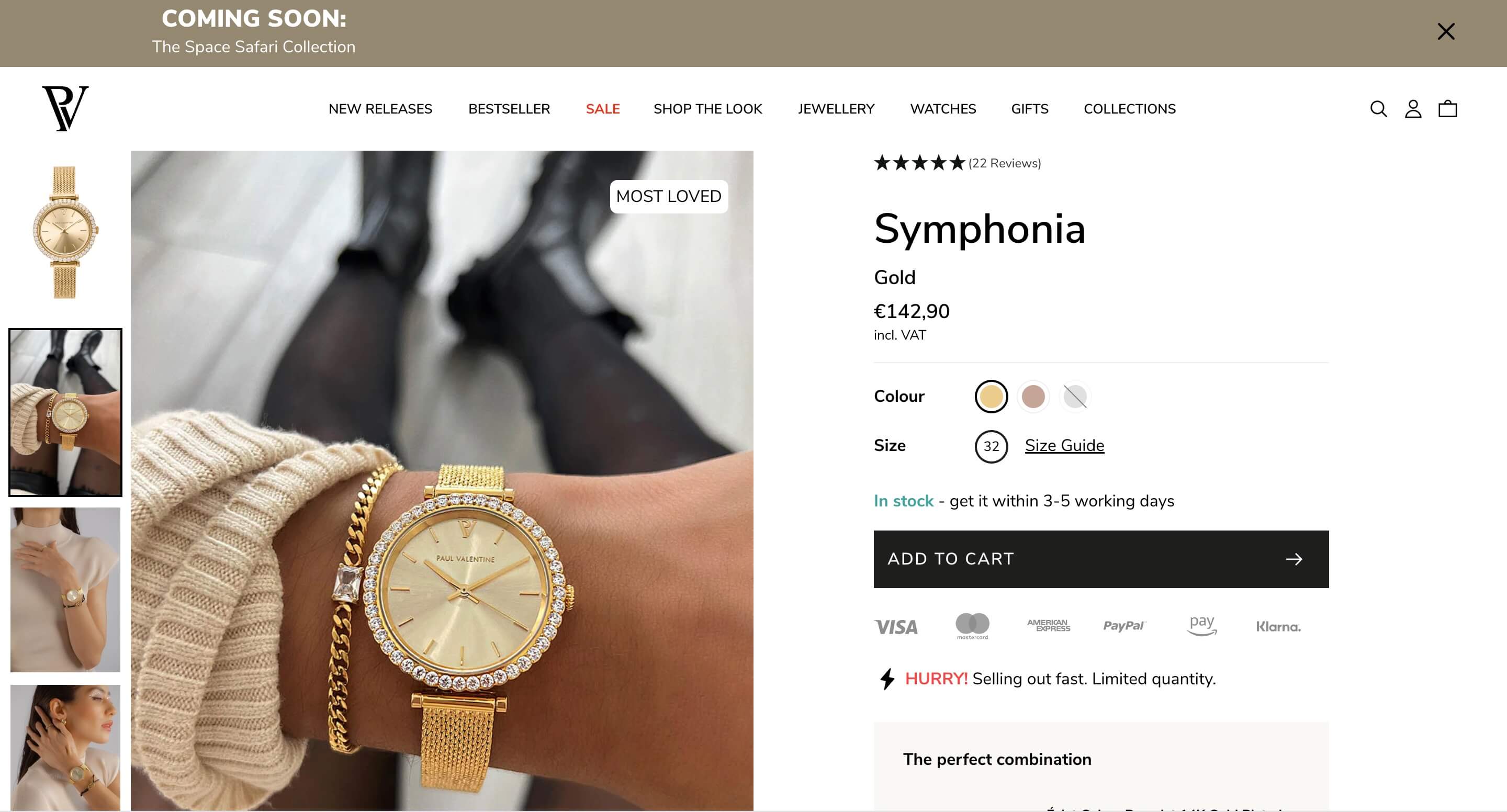
With Headless, Paul Valentine brand achieved:
-
International Expansion: Paul Valentine successfully established five international stores across Europe and North America, tailoring each to cater to local preferences and languages, effectively making the brand accessible in 131 countries through 20 global web stores.
-
Customization and Localization: The headless model allowed Paul Valentine to offer a personalized shopping experience for various markets, accommodating different languages and cultural nuances, which is critical for luxury brands aiming to provide superior customer service.
-
Infrastructure Management: By adopting a headless approach with Shopify Plus, Paul Valentine was able to streamline the management of its different global stores, enhancing operational efficiency and user experience.
13. Blume: Revolutionizing Skincare through Headless Commerce
Blume stands out in the beauty industry for its focus on authentic self-care, destigmatizing topics like acne and puberty, and promoting eco-friendly products. Their online platform is designed to engage a community, especially targeting Gen Z and millennials with relatable content and products.
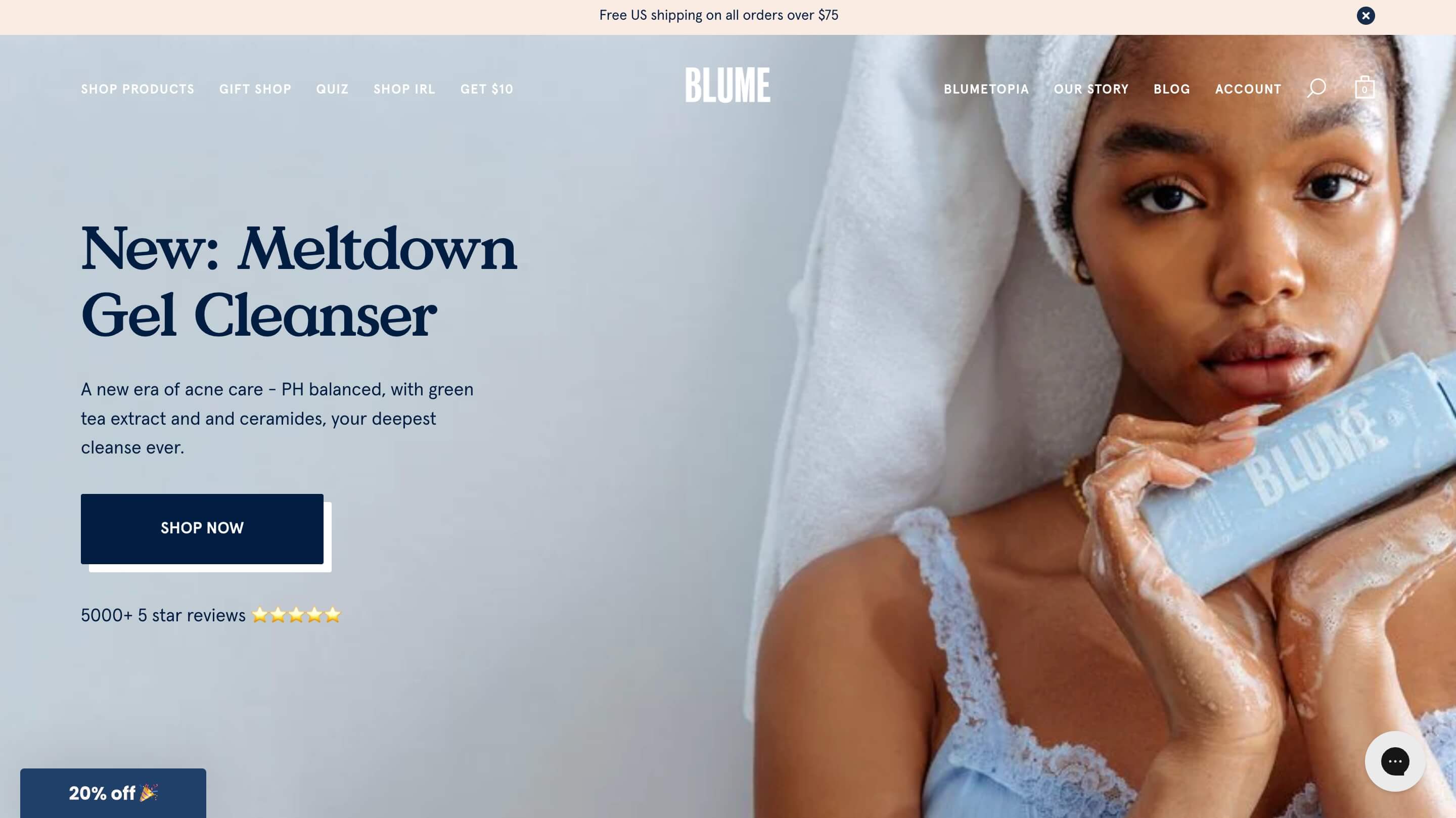
With Headless, Blume was able to:
-
Handle diverse and dynamic content tailored to their audience.
-
Integrate various third-party applications seamlessly.
-
Provide a personalized shopping experience across multiple channels.
-
Quickly adapt to market trends and customer feedback, enhancing their brand's agility.
Join the Discussion
Continue Reading
More insights from the Weaverse team

Building A Blazing Fast Shopify Store: Liquid or Hydrogen?
Someone once told me, “You don’t really need your website to go that fast.” I knew what they meant. I’d just spent five seconds waiting for Song for the Mute’s homepage to load. By any standard metric, that’s slow. But I didn’t care. When you’re browsing one of the coolest brands on the internet, and you really want to buy, you’re not timing it. You’re in it. You’re immersed. You’re seeing poetry, storytelling, and fashion blending perfectly together! But most stores aren’t Song for the Mute. And if your brand doesn’t have that kind of magnetic pull yet, performance matters — a lot. Google called it out years ago in their “Milliseconds Make Millions” report. Even today, 82% of users say slow speeds affect their purchasing decisions, and a 1-second improvement in page speed can yield an extra $7,000/day for a $100k/day site. Things haven’t changed. Now, if you're using a traditional Shopify theme, built on Liquid and your site feels sluggish, your first instinct might be to install a performance app. Don’t. Most of them do more harm than good. Others might suggest going headless. I build for Shopify Hydrogen, and even I’ll say this: don’t rush. Can Shopify Liquid Perform Well? Absolutely. Shopify published their own study in late 2023 showing that Liquid storefronts outperform most ecommerce platforms in Core Web Vitals. As of September 2023, 59.5% of Shopify sites passed all CWV thresholds, a stat that continues to climb. Even large-scale merchants like Rothy’s, Rad Power Bikes, and Dollar Shave Club use Liquid and still hit performance benchmarks. Surprisingly, Liquid even outperforms most headless implementations. Shopify found that many SSR frameworks — the ones powering most headless setups — had fewer sites passing Core Web Vitals compared to Liquid. Hydrogen ranked second, but there’s still a gap. So why invest millions in building Hydrogen? Just why? Hydrogen vs Liquid/Shopify Themes A Rebuttal Against Liquid First, I have to say that it might be hard to compare apples to apples in this case, mainly because the data in Shopify’s benchmark focuses on real storefronts using Hydrogen. Many of these early adopters built custom experiences without performance best practices. In contrast, Liquid storefronts benefit from: Years of optimization by Shopify's core teams Default themes like Dawn that are tightly optimized A templating model that constrains performance pitfalls Hydrogen, on the other hand, gives full freedom. Yes, this freedom cuts both ways; it brings performance potential and risk of poor implementation. Hydrogen storefronts can match or exceed Liquid performance when built well. Shopify’s own documentation even notes: “Some routes in the Hydrogen demo store template saw their load time cut in half” after optimizing GraphQL queries. Hydrogen is built on React Server Components (RSC) and uses Vite for ultra-fast development. Shopify chose this stack specifically because: RSC reduces client JS bundle size significantly Pages stream in progressively with lower Time to First Byte (TTFB) Data fetching is done on the server, not in the client render phase You get full control. You also get full responsibility. That’s why some Hydrogen stores load in half the time, and others fall flat. When Should You Consider Hydrogen? Page speed shouldn’t be the only factor in deciding between Shopify Hydrogen and Liquid. The real choice comes down to how much control you need over your storefront experience. If you’re planning to run A/B tests, personalize content, or build dynamic user interfaces, you’ll hit the limits of Liquid fast. Hydrogen is built for that kind of flexibility. It’s designed for brands that want to iterate quickly, experiment often, and optimize every touchpoint. On the other hand, Liquid works well for stores that prioritize simplicity and stability. Its guardrails are a strength if your store setup is relatively fixed, maybe with just a few campaign landing pages here and there. Use Hydrogen if: Your store has 500+ SKUs or 100K+ visits/month, and you’re seeing speed decline. You need to launch experiences that your theme can’t handle: multi-currency PWA, AR tools, immersive UIs. Your team (or agency) is fluent in React and headless workflows Stick with Liquid if: You’re validating a new product or category All your needs are covered within the theme editor, and your site already performs well You don’t have the engineering support to maintain a custom frontend The TL;DR In short, Liquid gives you structure. Hydrogen gives you freedom. Choose based on how far you plan to push your storefront. How To Build Hydrogen Storefronts Faster? One of the biggest reasons developers hesitate to go headless is that it breaks the visual editing experience. The Shopify Theme Editor disappears. Content teams are locked out. Everything becomes a Jira ticket. Weaverse fixes that. With Weaverse Hydrogen, developers can build Hydrogen themes and components via an SDK, expose them in a familiar drag-and-drop editor, just like Shopify Theme Editor, and let content teams reuse, remix, and publish without touching code. And it's only getting easier. With Weaverse AI, the gap between idea and execution shrinks dramatically. Developers will soon be able to turn Figma design into Hydrogen landing pages using Weaverse and Figma MCP. Merchants will soon be able to edit their Hydrogen storefronts using a natural language interface. If you’re interested in Weaverse AI, let me know here, and I’ll reach out once it’s ready!

The Future of Building with Shopify: Hydrogen and AI
Building An Online Store: Then & Now Let’s start with a story. A history lesson, perhaps. It is 1999. Your boss tells you the company needs an online store. You nod gravely and call your web guy. He nods back and disappears for six months. You don’t hear from him again until he returns with 10,000 lines of spaghetti PHP, a MySQL database held together with duct tape, and a shopping cart that breaks when you add more than three items. You launched anyway. The homepage has dancing gifs. The checkout form requires 12 fields. Half of your customers abandon their carts. You get one sale a day. But hey you’re a dot-com entrepreneur now. It is 2007. Your boss tells you the company needs an online store. You go to Magento and download the open-source package. You spin up a server, start following a forum thread with 43 pages titled “Help: Checkout Broken!” and spend the next few weeks configuring payment gateways, plugins, cron jobs, and SSL certificates. You hire a developer to customize the theme. He hardcodes your logo into the footer and disappears. You hire another developer to undo what the first one did. The store launches. It’s not great, but it works. Kind of. At least until the next security update. It is 2016. Your boss tells you the company needs an online store. You open Shopify. It takes you 45 minutes to get to your first product page. You feel powerful. You don’t need a developer. You need a laptop and a credit card. You buy a theme. You connect Stripe. You install a bunch of apps that each solve one extremely specific thing: reviews, popups, upsells, abandoned cart reminders, shipping rate calculators, order printers, email sequences, and chat widgets. It’s a Frankenstein monster of app integrations, but it’s yours. You ship. You sell. You sleep. Sort of. Then the cracks start showing. You want to customize the checkout? Sorry, you need Plus for that. You want a multilingual storefront with dynamic pricing across geographies? Maybe hire an agency. You want to build a branded mobile experience that feels native? Time to hire a dev again. It is 2023. Your boss tells you the company needs an online store and he needs it to be butterfly, fast, and performant. You’re familiar with React and you think Shopify's built-in functionalities are still pretty good, so you decide to build with Shopify Hydrogen. It’s Shopify’s answer to headless. It’s powerful. It lets your developers do things that Liquid never could. Your storefront looks stunning with buttery transitions and personalized landing pages. And still, your performance scores are through the roof. You’ve replaced four apps with custom code. But it also demands more. You’re writing GraphQL queries, managing server components, and wrestling with route loaders and caching strategies. Now your team is busy maintaining a headless stack, they barely have time to explain. What used to take hours now takes days. What used to take days now takes a roadmap. Everything is beautiful and nothing is simple. It is 2026. Your boss tells you the company needs an online store. You open Figma. Then you open Weaverse. You type something like: “Turn this Figma design into a Weaverse page. Five products. Ships worldwide. Prioritize mobile. Feels editorial.” You watch as the layout comes to life. The hero image loads before you finish your sentence. You adjust it with a message: “Make it taller. Add motion.” You change the font. You swap the checkout flow. You personalize the homepage with a prompt. It’s Hydrogen underneath, but you don’t feel it. The complexity of headless is still there. But it’s abstracted away from you, turned into something anyone can use. The future isn’t Hydrogen or AI. It’s Hydrogen plus AI. That’s how Weaverse AI is being built. And this time, everything is possible and simple. Introducing Weaverse AI, The First AI Store Builder for Shopify Hydrogen In 2022, Shopify launched Hydrogen, a React-based framework for building highly customizable, interactive, and high-performance storefronts for Shopify stores. Weaverse was created 6 months later. For years, we’ve been focused on one thing: helping Shopify merchants build better storefronts, faster. Before Hydrogen, that meant delivering Liquid-based themes that looked great out of the box and were easy to use. But Liquid has limits. Custom layout logic often requires installing third-party apps. Dynamic sections depend on metafield hacks. Over time, these workarounds pile up, slowing down performance and restricting flexibility. When Hydrogen became available, we saw a better path forward. Weaverse Hydrogen is our response: a platform that brings Hydrogen’s flexibility into a merchant-friendly environment. With Weaverse Hydrogen, developers can build Hydrogen themes and components via the SDK, make them configurable in the visual editor, and let content teams reuse and remix them across storefronts. Merchants can drag and drop prebuilt components into a Hydrogen-powered store, preview changes in real time, and deploy to Oxygen or locally with ease. It felt like Shopify Theme Editor, but as powerful as Hydrogen can be. Now we’re taking the next step with Weaverse AI. What Is Weaverse AI and What Can It Do? Weaverse AI helps developers, agencies, and merchants build Shopify Hydrogen stores faster using a natural language interface. Imagine describing the section you want—“three columns with product cards and buy buttons”—and it generates it. Upload a Figma file, and it scaffolds a matching theme. You start with a prompt and end with a shoppable page. This is where Weaverse AI leads. There are two major pieces behind this shift: 1/ Weaverse AI Assistant (inside Weaverse theme customizer): Merchants and marketers can build and update Hydrogen pages using natural language. Want a new banner? Change layout? Update styling? Just ask. Generated sections can be promoted to the component library and reused across the organization. 2/ Weaverse MCP (Model-Component-Pipeline): Developers can go from Figma to Hydrogen in one conversation. Unlike black-box generators, the output is developer-friendly, inspectable, and structured around Hydrogen code. Every section is visible to merchants, editable in the GUI, and tweakable by devs. AI defines schema, default values, and preview logic for seamless editing. For Developers: Build Less, Deliver More Faster Prototyping and Development: Weaverse AI speeds up development. Instead of building boilerplate sections from scratch, developers can scaffold pages from Figma designs and let AI handle the repetitive work. You focus on what matters: performance, business logic, and standout features. In practice, a developer could sketch out a site structure in Weaverse’s visual builder and let AI fill in the gaps, achieving in a day what might have taken a week. Less Maintenance Works: AI assistants can handle routine updates or bulk changes across a site. For example, if a client wants to change all CTA buttons to a different style, an AI could execute that change across the codebase. It’s easier to keep the storefront fresh and updated without a continuous manual slog. For Agencies: Faster Builds, Better Margin Higher Throughput, Shorter Timelines: With AI generating first drafts and a visual tool (Weaverse Theme Customizer) enabling rapid tweaks, projects that took months can now ship in weeks, without cutting corners. This means agencies can handle more clients in parallel or offer faster turnarounds, increasing their capacity and revenue potential. Custom for Everyone: Because baseline development is faster, agencies can spend more time on strategy, branding, and customization for each client. It becomes feasible to offer truly bespoke designs to even smaller clients, since the heavy lifting (coding the theme) is largely automated. Even small clients can afford something custom. AI removes the overhead, so you can offer premium service without premium dev hours. Productized Packages: Offer AI-assisted setup packages, budget Hydrogen builds, or retainers focused on optimization instead of maintenance. You move from vendor to strategic partner. For Merchants: More Control, Less Waiting No-code Visual Editing: Merchants can finally have the best of both worlds: the flexibility and speed of a custom headless site, and the ease-of-use of a Shopify page builder. You can launch landing pages, rearrange product sections, or update content without waiting on a dev. The builder is visual and intuitive, and the AI assistant can guide or even generate entire sections for you Faster Iteration. A/B test homepages. Add new sections for a campaign. Update product grids before lunch. With Hydrogen’s speed and AI’s flexibility, iteration is instant. You just chat. Lower Overhead. Reduce dependency on developers for day-to-day changes. Let AI help with SEO, performance suggestions, or layout fixes. You run a modern, high-converting store without needing a tech team on call.

Weaverse Pricing Update - More Free Usage, More Flexibility
Building a brand is tough. You’re constantly juggling priorities, from sales and marketing to product development—and everything costs money. When you’re starting, every penny matters. Your burn rate matters. As a startup ourselves, we understand this deeply. Weaverse is designed to help you build headless storefronts faster, bringing your vision to life. But we also know that’s only part of the equation. You need time and resources to truly scale and grow. This is why we released a new pricing update to offer our users more flexibility to grow, to scale, to win - without losing sleep over your burn rate. Here’s what’s new New Pay-As-You-Go Plan: Replacing our Free Plan, this option is ideal for those just starting out. You now get 10,000 free view credits (twice the previous 5,000!). Only pay as your store grows—simple, flexible, and effective. Introducing Grow Plan: Tailored for growing businesses. For $29/month, you get 200,000 view credits, along with a Service Level Agreement (SLA) and guaranteed response time to ensure your store runs smoothly even as you scale. Introducing Scale Plan: Designed for high-traffic stores. At $199/month, you’ll get 1.5 million view credits and priority access to our upcoming features, including Localization, A/B Testing, and Scheduling. What About Current Paid Users? Don’t worry, you’re covered. The new pricing doesn’t affect existing paid users. If you’re already on a legacy business plan, you can switch to any of the new plans with the same add-on pricing: $1 for every 10,000 views. Not Sure What View Credits Are? View credits are counted each time a page on your Hydrogen theme is viewed, whether it’s a first-time visit or a repeat view. This ensures that our pricing is directly linked to how much value you’re getting from Weaverse. For more details, check out our pricing page here. If you have any questions or concerns, just drop me a message on Linkedin!
Never miss an update
Subscribe to get the latest insights, tutorials, and best practices for building high-performance headless stores delivered to your inbox.
